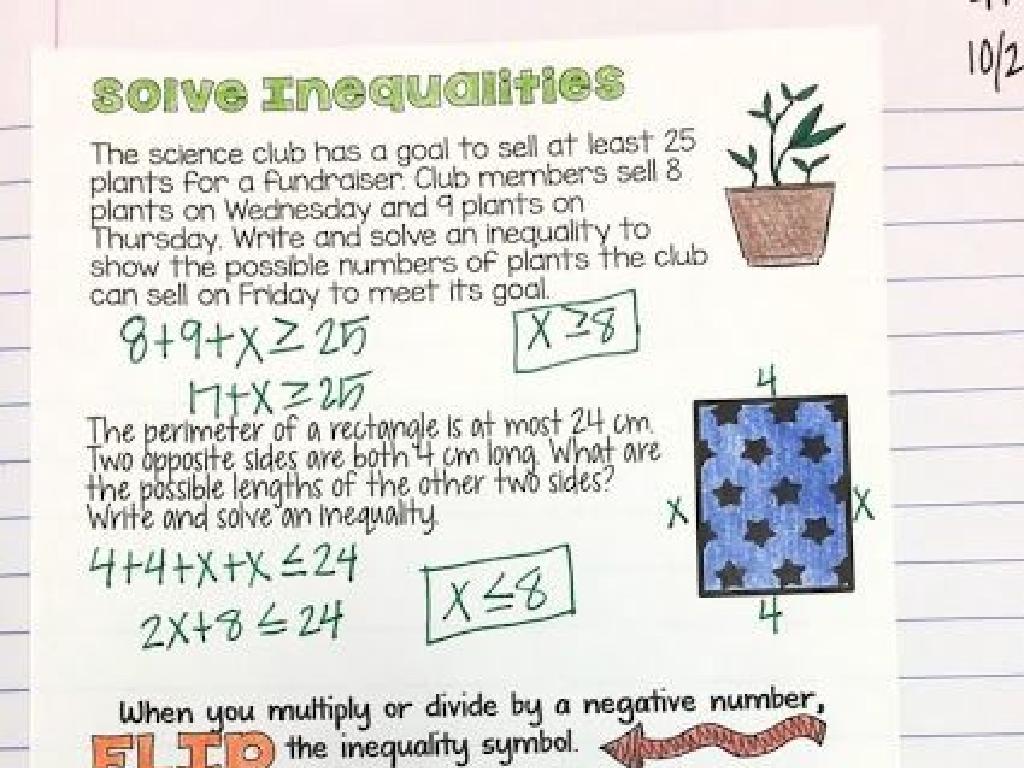Write An Equation From Words
Subject: Math
Grade: Sixth grade
Topic: One-Variable Equations
Please LOG IN to download the presentation. Access is available to registered users only.
View More Content
Introduction to One-Variable Equations
– What are one-variable equations?
– An equation with one unknown value, e.g., x + 5 = 12
– Equations and balance scales
– Both sides of an equation must be equal, like a balanced scale
– Real-life equation examples
– For instance, calculating total cost: item price (x) + tax = total
– Solving one-variable equations
– Find the value of x that makes the equation true
|
This slide introduces students to the concept of one-variable equations, which are fundamental in algebra. Start by explaining that an equation is a mathematical statement that asserts the equality of two expressions. Emphasize the idea of balance and equality by comparing equations to a balance scale, where both sides must be equal. Provide relatable examples, such as determining the total cost of an item with tax to illustrate how equations are used in everyday life. Finally, guide students through the process of solving for the unknown variable, reinforcing the concept that finding the value of x is like solving a puzzle to maintain balance on the scale. Encourage students to think of other real-life situations where equations are applicable.
Translating Words into Symbols
– Identify key math terms
– Terms like ‘sum’ mean ‘+’, ‘difference’ means ‘-‘
– Convert phrases to operations
– Phrases like ‘the product of’ translate to ‘*’
– Practice with word problems
– Solve problems by replacing words with symbols
– Turn words into math symbols
– Use symbols to write equations from word problems
|
This slide is aimed at helping students understand how to translate common English words and phrases into mathematical symbols, which is a crucial skill for writing equations. Start by discussing key terms such as ‘sum’, ‘difference’, ‘product’, and ‘quotient’, and what operations they correspond to. Then, show how to convert phrases into mathematical operations, for example, ‘the sum of a number and five’ becomes ‘x + 5’. Provide practice problems where students turn words into symbols, reinforcing the concept. Encourage students to work through word problems step by step, translating the words into an equation with symbols, which they can then solve. This will build a foundation for solving one-variable equations and improve their problem-solving skills.
Writing Equations from Words
– Steps to form equations
– Read carefully, identify numbers, variables, and operations
– Example: 6 times a number = 24
– ‘Six times a number’ translates to 6n, and ‘equals twenty-four’ to = 24
– Group activity: Craft your equations
– Use word statements to write your own equations
– Share and solve as a class
– Discuss different equations and solutions
|
This slide introduces the process of converting word problems into mathematical equations, a key skill in algebra. Start by explaining the steps: reading the problem, identifying key numerical information, variables, and operations implied by the words. Use the example ‘Six times a number equals twenty-four’ to show how to translate this into the equation 6n = 24. For the group activity, provide students with various word statements and ask them to form equations. This encourages collaboration and critical thinking. As a teacher, facilitate the activity by providing guidance and ensuring each group understands the task. After the activity, bring the class together to share their equations and discuss the different approaches to solving them. This will help reinforce their understanding and allow them to see multiple ways to approach a problem.
Solving One-Variable Equations
– Understanding equation basics
– Example: Solve 6x = 24
– If 6 times a number equals 24, what is the number?
– Class practice with equations
– Use examples from Slide 3 for hands-on practice
– Finding the variable’s value
– Use inverse operations to isolate x
|
This slide is aimed at helping students grasp the concept of solving one-variable equations. Start by explaining what an equation is and the goal of finding the value of the unknown variable. Use the example 6x = 24 to illustrate the process of solving an equation by finding the value of x that makes the equation true. In this case, dividing both sides by 6 reveals that x equals 4. During class practice, refer back to Slide 3 and encourage students to apply the same principles to solve additional equations. Emphasize the use of inverse operations such as addition, subtraction, multiplication, and division to isolate the variable and find its value. The notes should guide the teacher through the process and suggest various equations of similar difficulty for the class practice, ensuring that students can work through the problems with confidence.
Checking Your Solutions
– Importance of checking work
Ensures our answer solves the original problem.
– Substituting solutions back
Replace the variable with your solution and see if the equation is true.
– Practice: Verify solution accuracy
Solve equations and check your answers individually.
– Ensuring equation correctness
|
This slide emphasizes the significance of verifying the solutions to equations. Students should understand that checking their work helps confirm the accuracy of their answers and solidifies their understanding of the concepts. Demonstrate how to substitute the solution back into the original equation by replacing the variable with the found value and simplifying to see if the equation holds true. Provide individual practice problems for students to solve and then check their solutions. This process not only validates their answers but also reinforces the relationship between the equation and its solution. Encourage students to always check their work to develop good mathematical habits.
Equation Relay Race: Team Challenge
– Split into teams for the race
– Solve equations step-by-step on board
– Each member solves a part of the equation
– First team with correct answer wins
|
This class activity is designed to encourage teamwork and understanding of solving one-variable equations. Divide the class into small groups, and have each team line up in front of the board. Present an equation to the class, and each team member will take turns to solve one step of the equation on the board. It’s important to ensure that each student understands their part of the process. The first team to finish with the correct solution wins a point for their team. Possible variations of the activity could include different equations for each team, timed rounds, or bonus challenges for more complex equations. This activity will help reinforce the students’ skills in translating word problems into mathematical equations and solving them collaboratively.
Conclusion & Homework: Equations from Words
– Recap: Writing equations from words
– Practice is key to mastery
– Regular practice solidifies understanding
– Homework: 5 one-variable equations
– Create and write equations from given word problems
– Solve the written equations
– Find solutions to the equations you’ve written
|
As we conclude today’s lesson, remind students of the key steps in translating word problems into mathematical equations. Emphasize the importance of practice in mastering the skill of writing one-variable equations. For homework, students are tasked with creating and solving five one-variable equations from word problems. This will help reinforce their learning and provide an opportunity for them to apply what they’ve learned in class. Encourage them to think critically about the language used in word problems and how it translates to mathematical expressions. Provide guidance on how to approach solving the equations they’ve written, ensuring they understand each step of the process.






